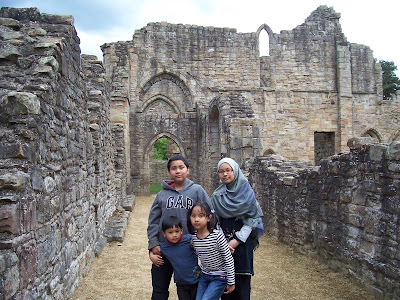The very extensive remains of a 13th century priory, founded on the site of a retired pirate's hermitage. Part of it later served as a holiday retreat for the monks of Durham Cathedral.
PEACE OF MIND......
Beautifully sited by the River Wear
EARLY HISTORY
Saint Godric of Finchale (or Saint Goderic) (c. 1065 – May 21, 1170) was an English hermitand popular medieval saint, although he was never formally canonized. He was born in Walpolein Norfolk and died in Finchale in County Durham, England.
Saint Godric's life was recorded by a contemporary of his: a monk named Reginald of Durham. Several other hagiographies are also extant. According to these accounts, Godric, who began from humble beginnings as the son of Ailward and Edwenna, "both of slender rank and wealth, but abundant in righteousness and virtue", was a pedlar, then a sailor and entrepreneur, and may have been the captain and owner of the ship that conveyed Baldwin I of Jerusalem to Jaffa in 1102. After years at sea, Godric reportedly went to the island of Lindisfarne and there encountered Saint Cuthbert; this will not have been a physical encounter as Cuthbert had long been dead and was by then interred under Durham Cathedral. This encounter changed his life, and he devoted himself to Christianity and service to God thereafter.
After many pilgrimages around the Mediterranean, Godric returned to England and lived with a hermit named Aelric for two years. Upon Aelric's death, Godric made one last pilgrimage to Jerusalem, and then returned home where he convinced Ranulf Flambard, the Bishop of Durham, to grant him a place to live as a hermit at Finchale, by the River Wear. He had previously served as doorkeeper, the lowest of the minor orders, at the hospital church of nearby St Giles Hospital in Durham. He is recorded to have lived at Finchale for the final sixty years of his life, occasionally meeting with visitors approved by the local prior. As the years passed, his reputation grew, and Thomas Becket and Pope Alexander III both reportedly sought Godric's advice as a wise and holy man.
Reginald describes Godric's physical attributes:
For he was vigorous and strenuous in mind, whole of limb and strong in body. He was of middle stature, broad-shouldered and deep-chested, with a long face, grey eyes most clear and piercing, bushy brows, a broad forehead, long and open nostrils, a nose of comely curve, and a pointed chin. His beard was thick, and longer than the ordinary, his mouth well-shaped, with lips of moderate thickness; in youth his hair was black, in age as white as snow; his neck was short and thick, knotted with veins and sinews; his legs were somewhat slender, his instep high, his knees hardened and horny with frequent kneeling; his whole skin rough beyond the ordinary, until all this roughness was softened by old age...
St Godric is perhaps best remembered for his kindness toward animals, and many stories recall his protection of the creatures who lived near his forest home. According to one of these, he hid a stag from pursuing hunters; according to another, he even allowed snakes to warm themselves by his fire.
 |
| Building of Finchale Priory began during the latter half of the 13th century |
 |
| .....from a hermitage, to a small monastery and place of pilgrimage, to a holiday home for the busy monks of Durham, and currently a monument of historical interest |
After Godric’s death, two monks of Durham moved to Finchale, where there was already a church, mill, dam and fish pond. The site has been a dependency of Durham Cathedral since 1196, the year in which the chapel hermitage became known as Finchale Priory. In this year it was endowed by Bishop Hugh Pudsey and his son Henry in order to support the priory’s eight monks and prior. Bishop Pudsey appointed Thomas, formerly sacrist of Durham, as prior. While Finchale was never to become a wealthy house, it was the richest of Durham’s dependencies by the mid-15th century.
The church remained in various stages of construction for over a century after 1196. The most significant change following its completion was the narrowing of the nave and the chancel during the 1360s and 1370s through the removal of the aisles. Various construction projects lasted at Finchale through the mid-15th century as the church dates in part from around 1200 and in others from the late 14th century.
source:wikipedia

























No comments:
Post a Comment